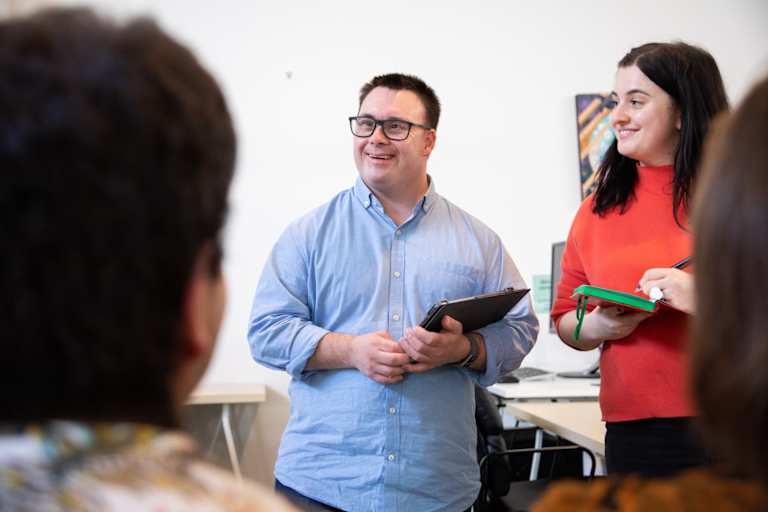What Is Art Therapy?
What is art therapy? How does it help people, and where is it used? Find answers and explore ways to enter and advance in this unique career path.Art therapy engages creativity as a tool for healing and growth. It prompts participants to create artworks, which the therapist and client then analyze and interpret together.
“In art therapy, clients use visual expression such as drawing, painting, collage, or other materials to better understand their thoughts, emotions, and experiences,” said Attiya Awadallah, LCAT, ATR-BC, a therapist with Lenora Art Therapy and Counseling, based in New York. “The process helps build insight, increase emotional regulation, and support healing, especially when traditional talk therapy feels too limited or difficult to access.”
The American Psychological Association (APA) recognizes art therapy’s ability to deepen self-insights, resolve trauma and conflict, and promote inner development. However, the practice does come with some caveats.
This guide explores the fundamentals of art therapy, answers common questions, and explores opportunities to build skills in this unique psychology specialization.
How Art Therapy Works
Some professionals encourage anyone seeking mental health help to consider art therapy, but certain populations may benefit from it more directly, including:
- People recovering from complex emotional or psychological trauma, strokes, or brain injuries
- People with developmental conditions or disabilities
- Children and adolescents
- Palliative care patients
- People recovering from substance use disorders
- People experiencing grief
Art therapy works in part by distracting the mind from intrusive, obsessive, or otherwise troubling thought patterns.
“Art therapy improves mental health by giving people a healthy outlet for difficult feelings like depression, grief, and anxiety,” said Naveen Khalfan, an art therapist and licensed marriage and family therapist practicing with Headspace, a popular meditation and wellness app. “When someone gets stuck in that exhausting cycle of anxious rumination — the mental hamster wheel that goes nowhere — art therapy redirects their focus to the present moment through concentrated creative work. This shift happens because your brain gets busy with creating, leaving less bandwidth for spiraling thoughts.”
Art therapists recognize the expressive potential of symbolism and sensory engagement. They encourage clients to create artworks without concern for traditional techniques, forms, or conventions. The therapist will then consider the artwork alongside the client, using guided prompts to help the client extract meaning and insight from their work.
“Art therapy offers a space where you don’t need to have the right words or even know where to begin. You just need to show up and be open to the process. Over time, it can help you feel more connected to yourself and more equipped to handle what life brings up,” Awadallah said. “It’s a powerful option for people who have tried talk therapy and want to go deeper, as well as for those who feel overwhelmed by language and are looking for a gentler way in.”
You can engage virtually any creative medium in art therapy. Popular choices include painting and drawing, sculpture, collage, and creative writing.
Does Art Therapy Work?
Client outcomes can vary, but multiple scientific studies have found evidence supporting art therapy’s effectiveness. For example, a 2022 research paper published in the Cureus medical journal described art therapy as an effective adjunct therapy that can improve mental health when used alongside conventional treatments.
“Many clients have told me that art therapy gave them an outlet when nothing else helped,” said Awadallah. They’ve discovered new coping tools, seen themselves from a completely different perspective, and noticed their confidence grow through the simple act of creating without judgment. Others have said it helped them be more present, less reactive, and more grounded in their daily lives.”
Along similar lines, a 2021 literature review published in the peer-reviewed Frontiers in Psychology journal examined more than 400 articles of published art therapy research. The paper linked art therapy to positive patient outcomes, especially for people with conditions such as Alzheimer’s disease, autism spectrum disorder, and schizophrenia.
Importantly, these and other studies generally characterize art therapy as most effective when used alongside other, more conventional techniques such as psychotherapy and cognitive-behavioral therapy. In these contexts, it can also help address mental health issues associated with mood disorders, anxiety, and psychological or emotional trauma.
However, practitioners must design and implement their therapy programs with care and caution. Art therapy can bring repressed emotions and memories to the surface, sometimes without warning. In some situations, this can cause stress and reopen past traumas.
Clients may also struggle to cope with unresolved emotions if they abruptly stop participating in art therapy sessions.
How Can I Become an Art Therapist?
A master’s degree is the minimum level of education needed to become an art therapy practitioner. Specifically, candidates should pursue a master’s degree in art therapy accredited by the Commission on Accreditation of Allied Health Educational Programs (CAAHEP).
Prerequisites vary among art therapy programs, but you do not necessarily need an undergraduate degree in psychology, counseling, or an arts discipline to qualify. However, you may need some foundational coursework in psychology prior to starting your master’s program in art therapy.
Other application materials may include:
- Resume or CV
- Personal essay or statement of purpose
- In-person or virtual interview
Many schools prefer or require that candidates have artistic or creative backgrounds. As part of your application process, you may also need to showcase a portfolio of original artworks.
In addition to a graduate degree, the AATA also requires the following to become an entry-level art therapy practitioner:
- 600 hours of supervised art therapy practice, obtained as part of an internship
- 100 hours of supervised practicum experience
- Prerequisite-level training in two- and three-dimensional studio art techniques
Depending on your state, you may also need additional psychology credentials or a license to work as an art therapist. Consult AATA’s licensure and certification guide for state-specific details.
Art Therapy Certification
AART participates in multiple national art therapy certification programs offered by the Art Therapy Credentials Board (ATCB). You can pursue four nationally recognized ATCB certifications:
- Provisional Registered Art Therapist (ATR-P)
- Registered Art Therapist (ATR)
- Board Certification (ATR-BC)
- Art Therapy Certified Supervisor (ATCS)
You can pursue ATR-P certification after completing your master’s degree in art therapy and starting your experiential training. You must have an ATR-P credential to qualify for the ATR designation, which recognizes your ability to practice independently.
The ATR-BC certification is the next level up from the ATR credential. It involves passing a national exam that tests your advanced knowledge of the clinical techniques and theoretical models in art therapy. ATCS certification is for experienced practitioners seeking to become training supervisors for emerging therapists.
FAQ: What Is Art Therapy?
Art therapy seeks to induce, accelerate, and deepen healing by engaging the creative process. Working under the guidance of a trained art therapist, participants spontaneously create artworks in their choice of supported media. In theory, this practice can help participants build deeper insights into themselves and organically uncover coping and healing tools.


